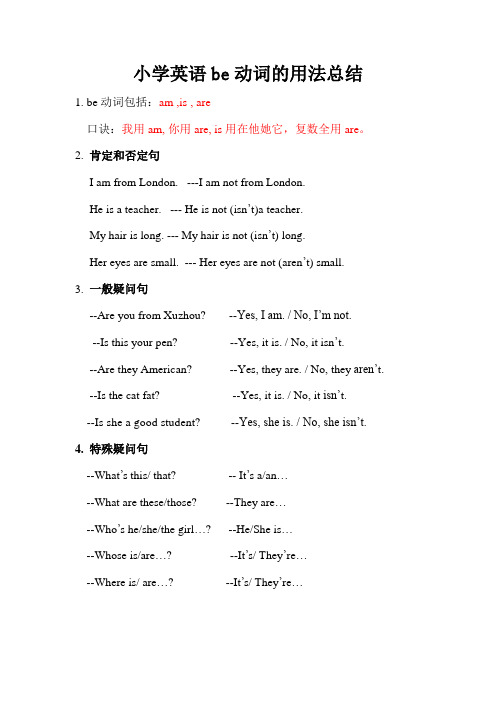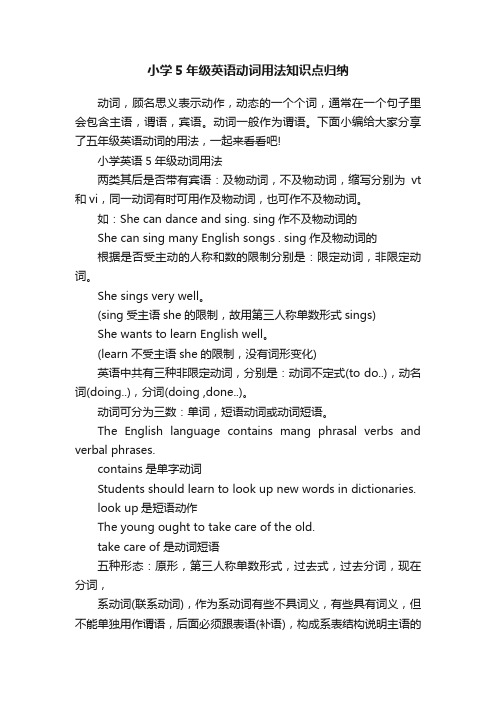小学英语动词用法总结
小学三年级重点知识总结情态动词的用法

小学三年级重点知识总结情态动词的用法情态动词是英语中的一个重要语法概念,用于表示说话人对所述内容的态度、观点或者对行为的推测、可能性等。
在小学三年级的英语学习中,情态动词的学习是一个重要的内容。
本文将总结小学三年级重点知识,并详细介绍情态动词的用法。
一、can/can'tcan表示某人有某种能力,能够做某件事情,比如:1. I can swim.(我会游泳。
)2. They can play basketball.(他们会打篮球。
)can't表示某人没有某种能力,不能做某件事情,比如:1. He can't ride a bicycle.(他不会骑自行车。
)2. We can't speak French.(我们不会说法语。
)二、may/may notmay表示允许、可能或推测等,用于表示某事情的可能性,比如:1. You may go to the party.(你可以去参加派对。
)2. She may be late for school.(她可能上学迟到。
)may not表示不允许、可能不或推测不等,用于表示某事情的不可能性,比如:1. They may not eat ice cream.(他们可能不吃冰淇淋。
)2. It may not rain tomorrow.(明天可能不会下雨。
)三、must/must notmust表示必须,用于表示肯定或强制性的命令和推测,比如:1. We must finish our homework.(我们必须完成作业。
)2. She must be tired.(她一定累了。
)must not表示禁止或不允许,用于表示否定的命令或禁止,比如:1. You must not eat in the classroom.(你不能在教室里吃东西。
)2. They must not be late for the meeting.(他们不可以迟到会议。
小学英语语法知识总结6篇

小学英语语法知识总结6篇英语语法是针对英语语言进行研究后,系统地总结归纳出来的一系列语言规则。
英语语法的精髓在于掌握语言的使用。
那么具体该如何总结呢?下面是为大家整理的小学英语语法知识总结6篇,希望大家能有所收获。
小学英语语法知识总结1一般过去时态(a) be 动词的过去式:I/He/she/it was(not)…. You/we/they were….一般疑问句was, were 放在句首。
(b) 动词过去式:肯定句:I watched cartoons.She visited the zoo.一般疑问句:Did you read book last night? Yes, I did. No, I didn’t.Did she clean the desk just now? Yes, she did. No, she didn’t.否定句:They didn’t go the the part yesterday.He didn’t make model ships last week.动词过去式变化规则:1.一般在动词末尾加-ed,如:pull-pulled, cook-cooked2.结尾是e加d,如:taste-tasted3.末尾是辅音字母加一个元音字母和一个辅音字母的重读闭音节,应双写末尾的辅音字母,再加-ed,如:stop-stopped4.以“辅音字母+y”结尾的,变y为i,再加-ed,如:study-studied5.不规则动词过去式:am,is-was,are-were,do-did,see-saw,say-said,give-gave,get-got,go-went,come-came,have-had,eat-ate,take-took,run-ran,sing-sang,put-put,make-made,read-read,write-wrote,draw-drew,drink-drank,swim-swam,sit-sat小学英语语法知识总结2动词加ing的变化规则1.一般情况下,直接加ing,如:cook-cooking2.以不发音的e结尾,去e加ing,如:make-making, taste-tasting3.如果末尾是辅音字母加一个元音字母和一个辅音字母,双写末尾的辅音字母,再加ing,如:run-running, stop-stopping 现在进行时,用来表示正在进行或发生的动作。
小学英语be动词的用法总结及练习题

小学英语be动词的用法总结1. be动词包括:am ,is , are口诀:我用am, 你用are, is用在他她它,复数全用are。
2. 肯定和否定句I am from London. ---I am not from London.He is a teacher. --- He is not (isn’t)a teacher.My hair is long. --- My hair is not (isn’t) long.Her eyes are small. --- Her eyes are not (aren’t) small.3. 一般疑问句--Are you from Xuzhou? --Yes, I am. / No, I’m not.--Is this your pen? --Yes, it is. / No, it isn’t.--Are they American? --Yes, they are. / No, they aren’t. --Is the cat fat? --Yes, it is. / No, it isn’t.--Is she a good student? --Yes, she is. / No, she isn’t.4. 特殊疑问句--What’s this/ that? -- It’s a/an…--What are these/those? --They are…--Who’s he/she/the girl…? --He/She is…--Whose is/are…? --It’s/ They’re…--Where is/ are…? --It’s/ They’re…小学英语be动词练习一、用恰当的be动词填空1. I ______ a boy. ______ you a boy? No, I _____ not.2. ______ David and Helen from England?3. The dog _______ tall and fat.4. You, he and I ______ from China.5. ______ your brother in the classroom?6. --Where _____ your mother? --She ______ at home.7. How _______ your father?8. Mike and Liu Tao ______ at school.9. Whose dress ______ this?10. Whose socks ______ they?11. Here _____ a cake for you.12. Here ______ some oranges for you.二、句型转换1. Our school is beautiful.否定句:______________________________________ 一般疑问句:__________________________________ 2. The bike is behind the tree.否定句:______________________________________ 一般疑问句:__________________________________ 对划线部分提问:__________________________。
小学5年级英语动词用法知识点归纳

小学5年级英语动词用法知识点归纳动词,顾名思义表示动作,动态的一个个词,通常在一个句子里会包含主语,谓语,宾语。
动词一般作为谓语。
下面小编给大家分享了五年级英语动词的用法,一起来看看吧!小学英语5年级动词用法两类其后是否带有宾语:及物动词,不及物动词,缩写分别为vt 和vi,同一动词有时可用作及物动词,也可作不及物动词。
如:She can dance and sing. sing作不及物动词的She can sing many English songs . sing作及物动词的根据是否受主动的人称和数的限制分别是:限定动词,非限定动词。
She sings very well。
(sing受主语she的限制,故用第三人称单数形式sings)She wants to learn English well。
(learn 不受主语she的限制,没有词形变化)英语中共有三种非限定动词,分别是:动词不定式(to do..),动名词(doing..),分词(doing ,done..)。
动词可分为三数:单词,短语动词或动词短语。
The English language contains mang phrasal verbs and verbal phrases.contains是单字动词Students should learn to look up new words in dictionaries.look up是短语动作The young ought to take care of the old.take care of 是动词短语五种形态:原形,第三人称单数形式,过去式,过去分词,现在分词,系动词(联系动词),作为系动词有些不具词义,有些具有词义,但不能单独用作谓语,后面必须跟表语(补语),构成系表结构说明主语的状况,性质,特征情况状态系动词:表示主语状态,只有be一词:如:He is a teacher . is 与补足语一起说明主语的身份。
小学英语常见动词短语总结

小学英语常见动词短语总结在小学英语学习过程中,动词短语(verb phrases)是非常重要的一部分,它们可以帮助我们描述动作和状态,使我们的语言更加流利和生动。
本文将为大家总结一些常见的小学英语动词短语,希望能为学习者提供一些帮助。
1. Wake up: 意为“醒来”,指从睡眠中醒来的动作。
例句:I wake up at 7 o'clock every morning.翻译:我每天早上7点醒来。
2. Get dressed: 意为“穿衣服”,表示穿衣的动作。
例句:Please get dressed before going out.翻译:出门前请穿好衣服。
3. Brush teeth: 意为“刷牙”,表示刷牙的动作。
例句:Remember to brush your teeth after meals.翻译:吃完饭后记得刷牙。
4. Go to school: 意为“去上学”,表示去学校的动作。
例句:I usually go to school by bus.翻译:我通常坐公交车去上学。
5. Have breakfast/lunch/dinner: 分别表示“吃早餐/午餐/晚餐”。
例句:I have breakfast at 7:30 every day.翻译:我每天7点半吃早餐。
6. Do homework: 意为“做作业”,表示完成作业的动作。
例句:Don't forget to do your homework tonight.翻译:别忘了今晚做作业。
7. Play sports/games: 分别表示“参加运动/玩游戏”的动作。
例句:We often play soccer on weekends.翻译:我们经常在周末踢足球。
8. Watch TV: 意为“看电视”,表示观看电视的动作。
例句:I like to watch TV before bedtime.翻译:睡觉前我喜欢看电视。
小学英语语法动词时态总结

小学英语语法动词时态总结一、一般现在时态(Simple Present Tense)1. 表示经常性或习惯性的动作、状态或真理。
例句:She often goes swimming in summer. (她经常夏天去游泳。
)例句:The earth revolves around the sun. (地球绕太阳转。
)2. 表示客观事实或永恒真理。
例句:Water boils at 100 degrees Celsius. (水在100摄氏度沸腾。
) 例句:The sun rises in the east. (太阳从东方升起。
)3. 表示现在的状态、感觉、持续的行为。
例句:I live in Beijing. (我住在北京。
)例句:She loves playing the piano. (她喜欢弹钢琴。
)二、一般过去时态(Simple Past Tense)1. 表示过去某个时间发生的动作、事件或状态。
例句:He finished his homework yesterday. (他昨天完成了作业。
) 例句:They visited their grandparents last summer. (他们去年夏天拜访了他们的祖父母。
)2. 表示过去的习惯或经常性的动作。
例句:She always wore a hat when she went out. (她出门时总是带着帽子。
)例句:They often played football after school. (他们放学后经常踢足球。
)第1页/共5页3. 表示过去的真理或现状。
例句:He thought the earth was flat. (他认为地球是平的。
)例句:The dinosaurs became extinct millions of years ago. (恐龙在几百万年前灭绝了。
)三、一般将来时态(Simple Future Tense)1. 表示将要发生的动作或事件。
小学四年级英语语法知识总结
一.助动词,b e ’动词应用 二.三单用法: he\she\it\人名\yourfather\myfriend\thewater\onebear …后面动词加s 或es ,有助动词在助动词上加e 或es.一句话中只有一处变三单加es 或s,有助动词does ,则动词不变。
如:Hedoesn ’tlikecows.Whatdoesyourmotherdo?Doeshelikecats? Thecowlikesgrass.口诀:Does 问,does 答,否定用doesn ’t 三.单复数用法:Howmucharethejeans?They ’re …yuan. Howmuchistheshirt ?It ’s …yuan.Wherearethedogs?Theyare …Whereisthesupermarket?\thedog?It ’s …. 四.any 和some 用法: (1)any 和some 后都要加名词复数:Doyouhaveanydress es ?\coats?\pajamas? Wehavesomeskrits.(2)any 用在疑问句和否定句,some 用在肯定句:Doyouhaveanycoats? Yes,wehavesome. No,wedon ’thaveany.五.主格、宾格、物主代词用法:{t hey?{ it?{ t hey?{i t?\she?\he?例:主格宾格Shelikesher.Helikeshim.Helikesme.Theyknowthem.主格物主代词Shelikesherfamily.Helikeshisfamily.Ilikemyfamily.物主代词Hisfatherisa…Hermotherisa….Myfatherisa…六.W词的意思:What什么Whatdoesshedo?Where哪里Whereisthesupermarket?Who谁Whoareyou?When何时Whendoyougotoschool?Why为什么Whose谁的Whosebookisit?How怎么Howmany…?多少Howmuch…?价钱。
小学英语情态动词的用法
小学英语情态动词的用法情态动词表示说话人对某一动作或状态的态度,表示“可能”、“应当”、“必要”等含义,但其本身词义不完全,不能独立作谓语,必须和动词原形连用。
那么接下来给大家分享一些关于小学英语情态动词的用法,希望对大家有所帮助。
小学英语情态动词的用法1.can和could的用法(1)can/could 表示“能力;许可;可能性”等。
could 为 can 的过去式。
如:Can I use your bike?我可以用你的自行车吗?(2)can 用在疑问句中,表示征求意见、请求许可,答语仍用can; could 用在疑问句中,比can 更委婉、客气,是一种礼貌的说法,并不表示过去时态,答语用can,而不能用could。
如:―Could you tell me the way to the zoo?你能告诉我去动物园的路吗?―Sorry. I can't. I'm new here。
不好意思,我不知道。
我是新来的。
[注意] can 和could 只能用于现在时和过去时两种时态,将来时中用 be able to。
另外, can't 可表示否定推测。
如:That ______ be Mr Wang. He has gone to Beijing。
那肯定不是王老师,他已经去北京了。
2.may和might的用法may/might 意为“可以”,表示同意、许可或请求对方许可,也可表示祝愿。
may的否定形式为 may not。
might 是may 的过去式,有两种用法:一种表示过去式;一种表示虚拟语气,使语气更加委婉、客气,或表示可能性更小。
以may开头的一般疑问句,其否定回答用mustn't, 而不用 may not。
如:______ I use your pen? 我可以用你用的钢笔吗?You may put on more clothes. 你可以多穿衣服。
May you be happy!祝你开心!Might I borrow some money now?我现在可以借点钱吗?He might be alive. 他可能还活着。
小学英语动词to do、动词ing和动词原形的用法总结及运用技巧
小学英语动词to do、动词ing和动词原形的用法总结及运用技巧动词to do、动词ing和动词原形是小学英语考试的难点,下面介绍它们的用法。
一、动词原形的用法1.在一般现在时中,主语非第三人称单数,其后的动词用原形,例如:We all like learning English.2.祈使句开头的动词用原形,例如:Be quiet!all of you.3.情态动词后面跟动词原形,例如:___ ___.4.固定搭配let sb do sth./make sb do sth./help sb do sth。
例如:Let's have some fun!5.助动词do/does/did以及它们的否定形式后面跟动词原形,例如:Does she read newspapers?6.why not do sth.为什么不做某事,例如:Why not sing a song?二、动词to do的用法1.动词to do形式表目的,放在句首时表达“为了”,放在句中或句末时表达“去干”,例如:To keep safe。
you shouldn't run on the road.2.动词to do也可以用在不定式结构中,例如:What should you do to cross the road safely?3.动词to do也可以用在一些固定搭配中,例如:I want to go to the park to play.以上是动词to do、动词ing和动词原形的用法总结,希望对大家有所帮助。
Beijing is a great n for travelers。
With its rich history and culture。
stunning architecture。
and us food。
it offers a ___ Forbidden City。
climb the Great Wall。
小学英语语法口诀
1. have/has 的用法have/has 表拥有,你有我有大家有;两种形式有不同,男他女她动物它,张三李四单个他,has 与之紧相伴;其他形式都跟have。
简单规则记心上,记心上。
2. Be 动词的用法Be 动词有三个:am is 还有are;I 的后面跟am; 男他女她动物它,张三李四单个他is 与之紧相伴,其他人称都用are。
3. 疑问词的用法疑问词放句首,what 什么;where 哪里;when 问时间;how 怎样;要问原因为什么,why 放句首就可以;疑问句有点难,勤做笔记多思考,遇问题别着急,先思考来后提问。
4. 人称代词的用法I 是我;you 是你;he,she ,it 他她它;I 的复数是个we;you 的复数还是you;男他女她动物它,张三李四单个他,他们的复数都是they;简单口诀要牢记,要牢记。
一、下面一些英语“口诀”可用来帮助学生记住一些常用词汇:1来是come,去是go,二人见面Howareyou?2你是you,我是I,二人分手Good-bye。
3father是爸,mother是妈,gohome是回家。
4Standup是起来,Sitdown是坐下,Haveacupoftea是喝茶。
5sister是妹,brother是哥,Listentome听我说。
6boy是男孩,girl是女孩,comein,please请进来。
7cat是猫,monkey是猴,听收音机listentotheradio。
8late是晚,early是早,takeabath洗个澡。
9old是旧,“新的”new,你几岁了Howoldareyou?10heavy是重,light是轻,Don’twory别担心。
11hot是热,cold是冷,Becareful要小心。
12push是推,walk是走,shakehands是握手。
13begin是开始,end是做完,havedinner是吃饭。
14shoes是鞋,clothes是衣,thirty一词是30。
- 1、下载文档前请自行甄别文档内容的完整性,平台不提供额外的编辑、内容补充、找答案等附加服务。
- 2、"仅部分预览"的文档,不可在线预览部分如存在完整性等问题,可反馈申请退款(可完整预览的文档不适用该条件!)。
- 3、如文档侵犯您的权益,请联系客服反馈,我们会尽快为您处理(人工客服工作时间:9:00-18:30)。
动词用法总结
(众亲们,把这张纸贴在你们的床头,一天三炷香,早晚拜三拜,保你百毒不侵,万病全消。
从此独步武林,笑看风云,傲视群雄,称霸天下。
)
动词+ing 的固定搭配
小学阶段:(四个)
1 Be+ doing 正在做某事
He is playing the piano. 他正在弹钢琴
2 Like + doing 喜欢做某事
He likes playing the piano. 他喜欢弹钢琴
3 介词+doing
常见介词有
at/in/for/after/before/about/by/from/of
He is good at playing the piano. 他擅长弹钢琴。
4 Go+ doing 去做某事
Go swimming 去游泳
Go climbing 去爬山
Go skating 去滑冰
Go shopping 去购物
Go fishing 去钓鱼
Go boating 去划船= go rowing
Go camping 去野营
Go skiing 去滑雪
Go cycling 去骑车
初一常考:(十六个)
1 Enjoy doing sth 喜欢做某事
He enjoys reading. 他喜欢读书
2 Practise doing sth 练习做某事
He practises playing the piano. 他练习弹钢琴。
3 Spend+time+ doing sth 花费时间做某事
He spends two hours playing the piano.
他花两个小时弹钢琴。
4 Finish doing sth 完成做某事
He finishes playing the piano.
他弹完钢琴.
5 Mind doing sth 介意做某事
Do you mind opening the window?
你介意开窗户吗?
6 See/hear sb doing sth 看到/听到某人做某事
I see her playing the piano?
我看见她在弹钢琴。
7 Hate doing sth 厌恶做某事
He hates playing the piano.
他厌恶弹钢琴。
8 Be worth doing sth 值得做某事
The book is worth reading. 这本书值得读。
9 Be busy doing sth 忙于做某事He is busy playing the piano. 他正忙着钢琴。
10 Be used to doing sth 习惯于做某事
He is used to playing the piano in the room.
他习惯在房间里弹钢琴。
11 can’t help doing 情不自禁做某事
He can’t help playing the piano.
他情不自禁地弹钢琴
12 have fun/a good time doing sth 做某事很开心He has fun playing football.
他踢足球很开心。
13 have great trouble/difficulty doing sth 费好大的劲做某事
He has great difficulty learning English.
他费了好大的劲学习英语。
14 look forward to doing sth 期待做某事
He looks forward to living with her.
他期待着和她住在一块。
15 stop doing sth 停止做某事(不做了)
He stops playing the piano.
他不弹钢琴了。
16 give up doing sth 放弃做某事
He gives up playing the piano.
他放弃弹钢琴.
注:stop to do sth 停下来去做某事
He stops to play the piano.
他停下来去弹钢琴。
动词原形
1 Let sb do sth 让某人做某事
Let us play the piano. 让我们弹钢琴。
2 Help sb do sth 帮助某人做某事
He helps me clean the room.
他帮我打扫教室。
3 情态动词+do
Needn’t do sth 没有必要做某事
You needn’t play the piano.
你没有必要弹钢琴。
4 Had better do 最好做某事
You had better play the piano.
你最好弹钢琴。
5 Make sb do sth 使某人做某事
He make me laugh. 他让我笑了。
6 why not do sth 为什么不做某事
Why not play the piano?
为什么不弹钢琴呢?
7 would you please do….. 请你做…好吗?
Would you please read for me?
请你为我读一下好吗?
8 make sb do sth 让某人做某事
五年级本周考试凸显问题:1. late 是形容词,与be动词连用. be late for school 上学迟到Is he late for school?他上学迟到了吗?Does he come late for school?他上学迟到了吗?因为第一句中没有动词,所以用is,第二句中有动词come,所以用does。
动词类型一定要看。
2 Eating too many sweets is b ad for us。
动词原形无法做主语,必须用动词的ing形式,动名词做主语表三单,用is。
3 看到the,一定要用序数词。
Look at the first traffic light 看第一个交通灯
4 在UK(英国)用toilet。
在US(美国)用restroom
5 遇见any ,必是否定句和疑问句
6 come out from 从......出来
7 The film is over 电影结束
了The film is on 电影开始了。
8 how to do sth 如何做某事。
